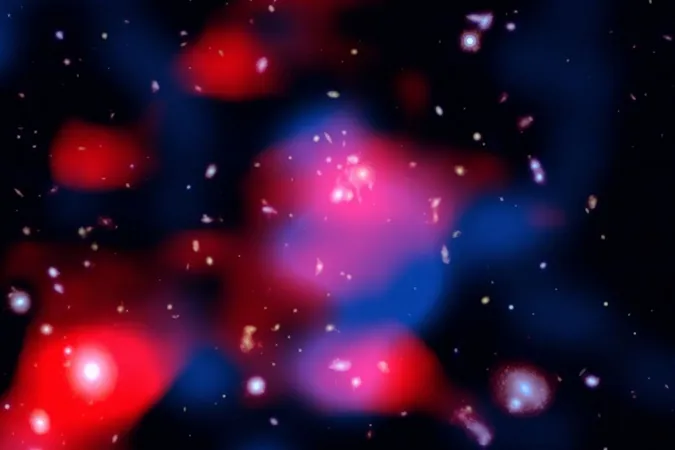
Unveiling the Cosmic Mystery: Distant Galaxy Cluster's High-Energy Halo Reveals Secrets of the Universe
2025-07-01
Author: Olivia
A monumental discovery has emerged from the vastness of space: a colossal cloud of high-energy particles enveloping a distant galaxy cluster that existed just four billion years after the Big Bang. This incredible halo could hold the key to unraveling the mysteries of how the early universe evolved.
A Staggering Discovery Across the Cosmos
Named SpARCS104922.6+564032.5, this massive cluster lies a staggering 9.9 billion light-years away from Earth, making it the most distant known example of a 'radio mini-halo.' Surprisingly, this mini-halo isn't small at all! Its radio signals have been traveling through space for 10 billion years—over three-quarters of the universe’s total age of 13.8 billion years.
Galaxy Clusters and Their Energetic Landscape
Utilizing the groundbreaking LOFAR (LOw Frequency ARray) radio instrument in Europe, researchers have unveiled that galaxy clusters—among the largest structures in the universe—are shrouded in high-energy particle envelopes for most of their lives. This revelation sheds light on the intricate flow of energy around these astronomical giants, enhancing our understanding of cosmic evolution.
What Fuels This Extraordinary Halo?
Scientists have proposed two intriguing theories regarding the origins of this mysterious mini-halo. One theory suggests that supermassive black holes at the core of the galaxies are ejecting jets of high-energy particles that accumulate around the cluster. However, this raises questions about how these particles maintain their energy levels.
The alternative idea is that a natural particle collider exists in the hot plasma surrounding the galaxy cluster, where particles collide at near-light speeds, generating the abundant high-energy particles we're witnessing.
A Peek into Cosmic History
This research presents a rare glimpse into a galaxy cluster shortly after its formation, indicating that these clusters might harbor energetic particles for billions of years longer than previously thought. With further investigation of this distant radio mini-halo, scientists hope to pinpoint the origins of these charged particles and deepen our understanding of the cosmos.
As study co-leader Roland Timmerman from Durham University exclaims, "It's astonishing to find such a strong radio signal at this distance!" This groundbreaking research opens new doors to understanding the processes that have sculpted galaxy clusters throughout the vast history of our universe.









 Brasil (PT)
Brasil (PT)
 Canada (EN)
Canada (EN)
 Chile (ES)
Chile (ES)
 Česko (CS)
Česko (CS)
 대한민국 (KO)
대한민국 (KO)
 España (ES)
España (ES)
 France (FR)
France (FR)
 Hong Kong (EN)
Hong Kong (EN)
 Italia (IT)
Italia (IT)
 日本 (JA)
日本 (JA)
 Magyarország (HU)
Magyarország (HU)
 Norge (NO)
Norge (NO)
 Polska (PL)
Polska (PL)
 Schweiz (DE)
Schweiz (DE)
 Singapore (EN)
Singapore (EN)
 Sverige (SV)
Sverige (SV)
 Suomi (FI)
Suomi (FI)
 Türkiye (TR)
Türkiye (TR)
 الإمارات العربية المتحدة (AR)
الإمارات العربية المتحدة (AR)